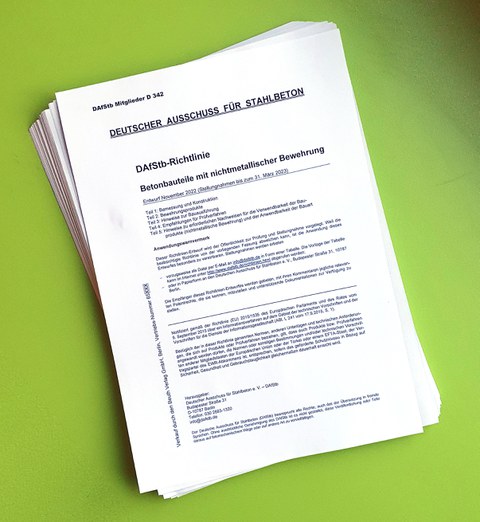DAfStb-Richtlinie „Betonbauteile mit nichtmetallischer Bewehrung"
Inhaltsverzeichnis
Projektdaten
|
Titel | Title |
Bericht aus dem Jahrbuch 2022
Der erste Schritt zur Norm

Gelbdruck der DAfStb-Richtlinie
Geforscht wird an nichtmetallischen Bewehrungen bereits seit über 20 Jahren, stets mit dem Ziel, einen hoch leistungsfähigen und gegen Korrosion resistenten Baustoff zu schaffen. Mehrere Bemessungsansätze konnten erstellt sowie an die fortlaufende Weiterentwicklung der Materialien angepasst werden, ein übergeordnetes Regelwerk fehlt allerdings nach wie vor. Mit der Aufnahme der nichtmetallischen Bewehrung in den Anhang R des Eurocode 2 ist ein erster Schritt bereits erfolgt. Die bisher umgesetzten baupraktischen Anwendungen basieren jedoch stets auf zeit- und kostenintensiven Zulassungen im Einzelfall.
Aus diesem Grund wurde 2018 in einem vom Deutschen Ausschuss für Stahlbeton e. V. (DAfStb) geleiteten Konsortium, bestehend aus über 30 Partnern aus Wirtschaft, Forschung und Behörden, mit dem Erstellen einer Richtlinie für den Einsatz nichtmetallischer Bewerhung im Betonbau begonnen, deren Gelbdruck im November 2022 veröffentlicht wurde. Die Frist für Stellungnahmen läuft bis zum 31. März 2023.
Die Richtlinie besteht aus fünf Abschnitten. Im Vordergrund steht der erste Teil, der die an den Eurocode 2 angelehnte statische Bemessung und konstruktive Durchbildung von Betonbauteilen mit nichtmetallischer Bewehrung regelt. Dabei beschränkt sich der Anwendungsbereich der Richtlinie auf überwiegend statische Beanspruchungen und Bauteile ohne Vorspannung. Im zweiten Teil der Richtlinie werden die Anforderungen an die Bewehrungsprodukte sowie Vorgaben zu erforderlichen Kennwerten an die Produzenten geregelt. Ergänzend dazu enthält der vierte Teil der Richtlinie Empfehlungen zu den Prüfverfahren, um die erforderlichen Materialkennwerte zu ermitteln. Besonderheiten, die sich in der Bauausführung mit den neuen Werkstoffen ergeben, werden im dritten Teil der Richtlinie beschrieben. Abschließend werden in Teil 5 Hinweise zu erforderlichen Nachweisen für die Verwendbarkeit nichtmetallischer Bewehrungen und zur Anwendbarkeit der Bauart gegeben, die die Planer:innen durch den aktuell erforderlichen Anwendungsprozess führen.
Zudem war das Institut für Massivbau der TU Dresden am Verbundvorhaben C3-L9 beteiligt, dessen Ziel ebenfalls ein Richtlinienentwurf war. Inhaltlich wurden dabei auch Forschungsergebnisse berücksichtigt, die in der derzeitigen Richtlinie noch keine Anwendung finden, u. a. Ansätze für die Vorspannung und dynamische Beanspruchung. Die Ergebnisse aus dem Projekt C3-L9 sollen als Vorlage für künftige Neuauflagen der Richtlinie dienen.
